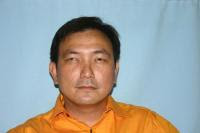With a long weekend vacation ahead of us, I together with fellow ALPer VP Dr. Jett Aguilar went to Caliraya, Laguna in the late afternoon to try to observe and image some deep sky objects there as it has still good dark skies in our setup area.
We arrived at around 7:00pm and setup our mount while Polaris is still visible. I brought a portable setup consisting of Canon EOS 500D DSLR on Canon EF 100-400mm f/4.5-5.6 IS L lens mounted on top of my portable Kenko Sky Memo-R tracker to follow the stars. Jett , on the other hand brought along his Takahashi TSA-102 refractor with Canon EOS 50D DSLR mounted on top of Vixen GP-DX mount.
After we polar aligned our mount, there was a slight drizzle that lasted only a few minutes but the sky was very beautiful afterwards! We then had our dinner first as both of us are quite hungry already from the long travel. Afterwards, we started to image the night sky.
Andromeda Galaxy was positioned high so I took the chance to image our Milky Way's closest galaxy, M31 Andromeda Galaxy together with its 2 galaxy companion M32 and M110. I was able to exposed more than 1 hour of total exposure for the said object. I then prepare to image my next object , Helix Nebula and California Nebula but since it is near the zenith already, I had a hard time composing the said objects, thus I then proceeded to my next object on my list which is the B33 Horsehead Nebula and NGC2024 Flame Nebula in Orion. But as I was starting to image it after midnight, clouds started to roll in partially so I was only able to exposed for half of my planned total exposure for the said object. Since then, I had to play cat and mouse with the clouds to expose in between breaks in the clouds till around 2:40am when thick clouds started to cover the sky thus shortened my imaging session :( I was planning to still wait but I started to feel sleepy already and tired thus I sleep on the car while Jett still manage to wait for a few more shot before calling it a night as well. Jett was also able to tame his mount and in the latter half of the night was able to run the mount a bit smoothly. So he was bale to image Orion Nebula and Horsehead Nebula as well.
At around 9:00am after we had a short coffee and some light breakfast, we head back t Manila with a good feeling from our imaging session at Caliraya as the moments of observing and imaging under a dark sky was a privilege that I will always cherish on our numerous observing session s there. We are looking forward to going back in the next New Moon weekend to continue to image the other objects in our list :)























































